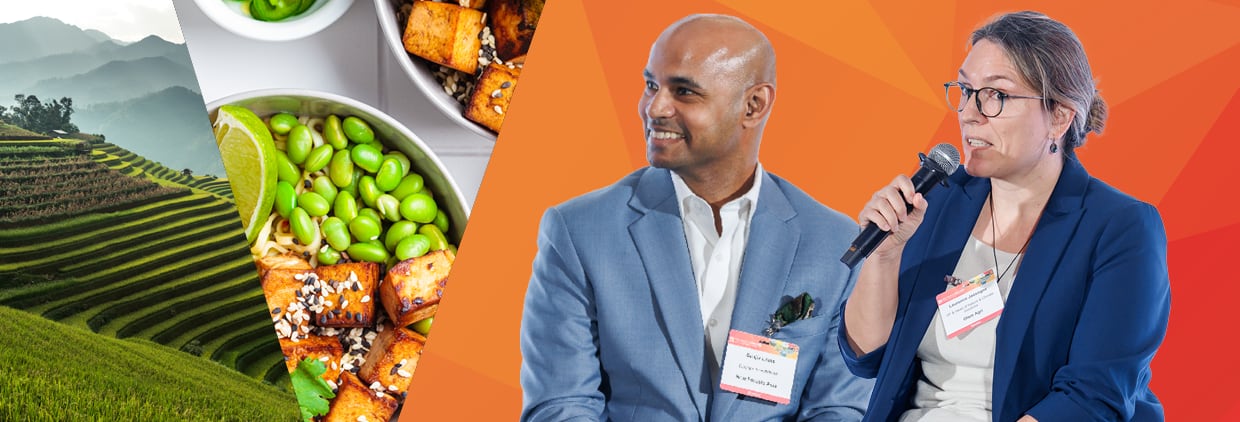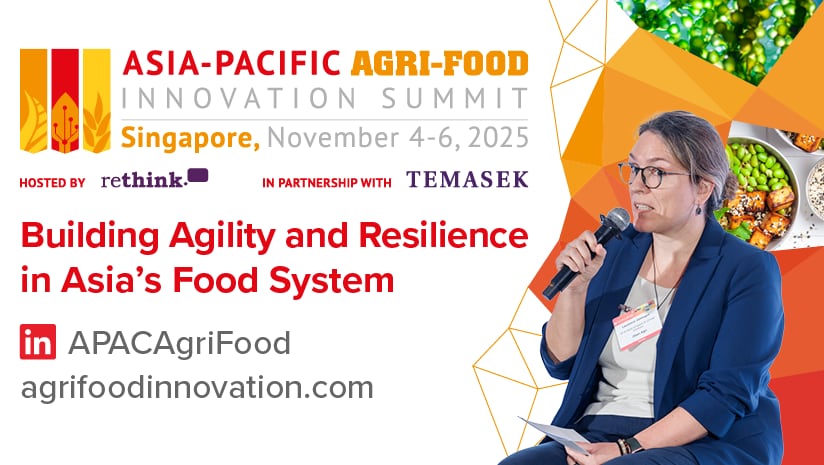As the Asia-Pacific agri-food market continues to expand, regional collaboration is a critical opportunity for building security across key crop supply chains.
The expansion of the agri-food market in Asia Pacific is driven by urbanisation, economic growth and demographic shifts. Rapid urban development is reducing the availability of agricultural land, while changing population dynamics are altering consumption.
Meanwhile, the climate crisis is accelerating across the region, and rapidly evolving regulation and shifting trade relationships are adding another layer of complexity. This requires agri-food stakeholders up and down the value chain to manage the dual pressures of navigating shocks and adapting to systemic change.
Strengthening regional networks can help to build supply chain agility and security by ensuring open and inclusive trading systems, climate change adaptation and consistent supply.
So, what opportunities are available to help agribusinesses and food brands adapt to shocks and stay ahead of the curve?
Connecting the dots in key crop supply chains
Rice
Rice farming is central to Asia Pacific’s agricultural identity. Considering over 90% of global rice is produced and consumed in Asia, its production is crucial for ensuring food security and livelihoods.¹ However, rice consumption in China, India and Indonesia is projected to outpace population growth, increasing by more than 51% from 1995 to 2025.¹
While this upward projection is promising, it also creates challenges. Rice production is influenced by both climate and market factors. Currently, the sector faces environmental degradation, fluctuating prices and food insecurity – in addition to the rapid development of megacities in the region which will significantly reduce agricultural land.
Innovation here is essential. Alternative farming practices such as alternate wetting and drying (AWD) are being introduced to replace traditional flooded rice cultivation. AWD is a water-saving technique for rice cultivation that involves periodically draining and re-flooding the field. This helps to reduce water consumption and greenhouse gas emissions.
Additionally, practices like direct seeding of rice (DSR) are being introduced. Direct seeding is a method of establishing a rice crop by sowing seeds directly into the field rather than transplanting seedlings. It can accelerate crop establishment and expand planting windows, potentially increasing crop areas and overall yield. DSR also reduces labour requirements and the need for irrigation, conserving water at a time when it is becoming a scarce resource in Asia Pacific.
Although positive on many levels, such innovations can create new challenges. These practices require new approaches to weed and disease control as lack of flooding in fields can contribute to weed growth and complicate seed survival. Additionally, direct seeding can require investment into specific soil preparation and specialised equipment.
To support these transitions – especially for smallholder farmers – affordable and accessible technologies are essential, alongside improved access to knowledge and agricultural inputs.
Palm oil
Palm oil is incorporated in almost 50% of supermarket products and is the world’s most widely used vegetable oil thanks to its abundance and versatile properties.² However, its adaptability comes at a price.
Palm oil production is controversial, with negative links to ESG impacts, particularly deforestation, biodiversity loss, land grabbing and poor labour conditions. So, how are palm oil plantations transitioning to more sustainable practices?
The transition involves a multifaceted approach among companies, governments and consumers. While this is gaining momentum, traceability and sustainability issues require a full-value chain effort.
One of the most important elements of these endeavours, smallholder inclusion, is crucial to fully map supply chains and introduce sustainable farming practices across operations large and small. But it can be tricky for various reasons, from digital literacy and connectivity gaps to trust.
Export regulations on traceability and sustainability, including climate reporting requirements, present additional challenges. For example, the EUDR – which continues to evolve – requires that exported commodities be produced legally and deforestation-free.³ Commodities illegally produced on deforested land after December 2020, or if a product is not traceable, cannot be placed in EU markets.
The Roundtable on Sustainable Palm Oil (RSPO) has been promoting sustainable palm oil practices through its multi-stakeholder initiative, encompassing over 5,000 stakeholders across 101 countries including agribusinesses, governments and NGOs.⁴ It provides certifications for compliant producers which promote traceability and offers tailored support for smallholders. By unifying stakeholders, the RSPO has created a platform to transform how palm oil is produced, traded and sold.
And it is also important to consider alternative avenues of production. We know palm oil is a major crop, but how can it be complemented by new food-tech solutions? Lab-grown alternatives are one example. Using a fermentation process, microorganisms like yeast can be used to form a bio-equivalent cultivated alternative to palm oil. Alongside the introduction of traceable and sustainable palm practices, innovations like these can reduce reliance on palm oil.
Fresh produce and specialty crops
Fresh produce such as tropical fruits and vegetables, and specialty crops like berries are increasingly important products in Asia Pacific’s agri-food sector. Asia Pacific is a significant producer of fresh produce, enjoying a range of climates perfect for cultivating these crops, along with a dense population to create demand. And with regional consumers looking towards healthier diets, the market opens opportunities for expansion and economic growth.
But while there is an opportunity to tap into growing branded and non-branded markets, producers must ensure they address rapidly evolving climate challenges.
The fresh produce and specialty crop supply chain is, for example, finding the balance between open field and controlled environment agriculture to build climate resilience and maximise growth. Open field innovation focuses on improving or replacing traditional intensive farming methods, whereas controlled environment agriculture utilises technology to optimise growing conditions.
Greenhouses are a key component of controlled environment agriculture. As climate threats intensify, a greenhouse – particularly a high-tech greenhouse – can protect crops from the elements and fluctuating temperatures. By stabilising growing conditions, farmers can improve yields and crop quality, and reduce reliance on pesticides and herbicides.
But innovation alone isn’t enough – how can we ensure smallholders have the financial tools to participate in this transformation?
Improved financing for smallholders
Smallholder farms hold significance across the entire Asia-Pacific agri-food sector. In fact, they produce approximately 60% of the region’s agricultural output.⁵ Yet, despite their importance, smallholders often face barriers that hinder their ability to adopt new practices.
Most smallholder farmers face difficulties accessing investment, primarily due to lack of data showing farms’ performance. To bridge these gaps, collaboration among the innovation ecosystem of governments, agribusinesses, CPGs, development banks, NGOs and startups is essential. Initiatives that provide innovative financing alongside training and digital tools can help unlock productivity and enhance resilience.
For example, The Bank for Agriculture and Agricultural Cooperatives (BAAC) successfully launched an enhanced Loan Processing System (LPS), developed in partnership with the TechXPlattnera Collaboration Group.⁶ The LPS project aims to enhance the efficiency and capability of BAAC’s loan services and collateral management systems. The partnership represents a pivotal advancement in broadening equitable and inclusive access to financial products for Thai farmers.
Ensuring that these small-scale farms are included in the transition to sustainability is vital for long-term food security. Across rice, palm oil, fresh produce and specialty crops, innovation must be matched with inclusive financing and regional collaboration across the entire agri-food innovation ecosystem up and downstream. Only then can Asia Pacific’s agri-food sector meet the challenges ahead.
Next steps: Expanding public-private partnerships
Public-private partnerships (PPPs) play a crucial role in building regional networks. From providing blended finance and launching pilots to delivering impact, working in alignment government and industry across Asia Pacific can catalyse and scale up innovation in a fragmented market, and ultimately, build agile and resilient supply chains.
By aligning government policy, industry expertise and innovation capital, regional collaboration through PPPs can unlock scalable solutions to some of the region’s most pressing challenges – from climate resilience and food security to supply chain transparency and smallholder inclusion.
These partnerships are increasingly focused on:
- Blended finance models De-risk investment in emerging technologies and sustainable practices
- Pilot programmes Test new approaches to regenerative agriculture, digital traceability and climate-smart inputs
- Innovation hubs and accelerators Bring together startups, corporates and research institutions to co-develop regionally relevant solutions
- Capacity-building initiatives Equip smallholders with the tools, training and market access needed to participate in modern agri-food systems
To support regional collaboration and public-private partnerships, the Asia-Pacific Agri-Food Innovation Summit – organised by Rethink Events in partnership with Temasek as the anchor event of Singapore International Agri-Food Week (SIAW) – returns to Singapore on November 4-6.
Bringing together 1,000 senior decision-makers from agribusinesses, food and ingredients brands, governments, investors, philanthropic organisations and startups, the summit provides critical intelligence on the future of agri-food innovation in Asia Pacific. It connects the dots across the value chain and region – from Singapore, China and Australia to India, Thailand, and beyond.
Register here for the Asia-Pacific Agri-Food Innovation Summit to access three days of pivotal discussions and unmatched networking opportunities at Marina Bay Sands, Singapore on 4-6 November. Special early bird rates are available until 11 September.
References
- FAO. Rice production in the Asia-Pacific region: Issues and perspectives.
- WWF. 8 things to know about palm oil.
- European Commission. Traceability and geolocation of commodities subject to EUDR.
- RSPO. Delivering Deforestation-Free Sustainable Palm Oil: A response to U.S. engagement on supply chain.
- Earth.org. Smallholder Farmers in Asia: Challenges, Opportunities, and the Path to Sustainable Food Production.
- SCB Tech X. Bank for Agriculture and Agricultural Cooperatives (BAAC) and TechXPlattnera Collaboration Group Announce Nationwide Implementation of Enhanced Loan Processing System.



